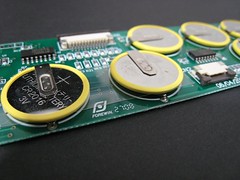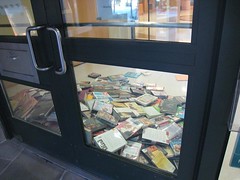
. Today I picked up the October 2008 issue of Esquire at a local bookstore. Since I live in the technological adept center of Silicon Valley, I was worried that the tech savvy engineers in the area would pick up a few issues to disassemble, and re-assemble as their own DIY e-ink reader, but, as the bookstore had more than enough magazines available, I suspect that either the e-ink display on the cover has been found wanting, or that the overlap between techies interested in such projects and the readership of Esquire isn't very large.
This issue of Esquire is a dollar more than the typical cover price of the magazine for the added costs of the display, and the batteries that powers the display.
In the interest of curiosity, I dismembered my issue to find out exactly what makes the cover work.
The cover you'll notice is very thick -- this is because the cover includes 2 e-ink displays, a circuit board with 6 CR2016 3V batteries, a foam insert and a whole lot of glue and tape to seal it up.
The batteries used are soldered onto the circuit board, making replacement of the batteries in order to retain the power going to the displays pretty impossible without tearing apart the cover.
Layered on top of the e-ink displays are a plastic cover which seems to serve the dual purpose of protecting the display, as well as providing colored elements to turn on or off. The e-ink doesn't have very much in the way of color reproduction -- it really feels like it's either on or off. The circuit boards have a manufacture date of 6/04/2008, making me curious how long these batteries will power the screen.
The screens are attached to the circuit board by way of a thin flat ribbon, and are attached to the e-ink displays. rather than returning to what we would consider an "off" state, the e-ink displays retain whatever image was last displayed when disconnected.
The verdict? Not much can be done in terms of DIY hacking unlless you have some way of removing the backing from the e-ink, and even then, the e-ink display is a cell type, not a pixel type, making hacks limited. The patterns may be able to be manipulated, but it is far beyond my technical capacities. The resolution of e-ink screen is difficult to distinguish from print, so that is a success, however, with the circulation of Esquire Magazine, and the propensity for magazines to end up in landfills, the sheer amount of batteries and electronics that may find their resting place there is staggering.








